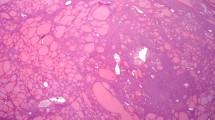Abstract
While focal myxoid areas are occasionally observed in solitary fibrous tumors, neoplasms of this type exhibiting extensive myxoid change are considered exceedingly uncommon. Due to their rarity, the biologic behavior of myxoid solitary fibrous tumor has not been determined. Three cases of myxoid solitary fibrous tumor are described in order to better characterize the clinical and pathologic features of this uncommon variant of solitary fibrous tumor. The tumors occurred in one man and two women, with ages of 37, 47, and 58 years, respectively. Sites of involvement included the retroperitoneum, pelvis, and soft tissue of the neck. Histologically, all cases were characterized predominantly by the presence of myxoid stroma comprising 70% to 100% of the tumor. The tumor cells were predominantly spindled in all cases, and arranged randomly, in loose fascicles, or in anastomosing strands imparting a microcystic/reticular appearance. The lesional cells had a bland cytologic appearance and low mitotic count. All tumors lacked necrosis and areas of increased cellularity. By immunohistochemistry, all cases were positive for CD34, CD99, and bcl-2, and negative for keratin, epithelial membrane antigen, desmin, actin, smooth muscle actin, and S-100 protein. To date, all cases have followed a benign course without evidence of recurrence or metastasis with a follow-up duration ranging from 50 to 87 months. The data suggest that myxoid solitary fibrous tumors are associated with an indolent clinical course and favorable prognosis.

Similar content being viewed by others
References
Chan JK (1997) Solitary fibrous tumour-everywhere, and a diagnosis in vogue. Histopathology 31:568–576
Gengler C, Guillou L (2006) Solitary fibrous tumour and haemangiopericytoma: evolution of a concept. Histopathology 48:63–74
Suster S, Nascimento AG, Miettinen M et al (1995) Solitary fibrous tumors of soft tissue. A clinicopathologic and immunohistochemical study of 12 cases. Am J Surg Pathol 19:1257–1266
Vallat-Decouvelaere AV, Dry SM, Fletcher CD (1998) Atypical and malignant solitary fibrous tumors in extrathoracic locations: evidence of their comparability to intra-thoracic tumors. Am J Surg Pathol 22:1501–1511
Hasegawa T, Matsuno Y, Shimoda T et al (1999) Extrathoracic solitary fibrous tumors: their histological variability and potentially aggressive behavior. Hum Pathol 30:1464–1473
de Saint Aubain Somerhausen N, Rubin BP, Fletcher CD (1999) Myxoid solitary fibrous tumor: a study of seven cases with emphasis on differential diagnosis. Mod Pathol 12:463–471
Chang SE, Bae GY, Choi JH et al (2002) Cutaneous solitary fibrous tumour with myxoid stroma. Br J Dermatol 147:1267–1269
Yap T, Hamzah L, Oshowo A, Taylor I (2003) Myxoid solitary fibrous tumour of the ischiorectal fossa. Eur J Surg Oncol 29:98–100
Pakasa NM, Pasquier B, Chambonnière ML et al (2005) Atypical presentations of solitary fibrous tumors of the central nervous system: an analysis of unusual clinicopathological and outcome patterns in three new cases with a review of the literature. Virchows Arch 447:81–86
Cheng NC, Tang YB, Liang CW et al (2005) Myxoid solitary fibrous tumour of the axilla. J Plast Reconstr Aesthet Surg 59:86–89
Wei YC, Li CF, Sung MT et al (2006) Primary myxoid solitary fibrous tumor involving the seminal vesicle. Pathol Int 56:642–644
Kösem M, Arslan M, Kontaş O et al (2006) Myxoid solitary fibrous tumour of the meninges: case report. Histopathology 49:443–445
Shin SS, Jeong YY, Kang HK (2008) Myxoid solitary fibrous tumor of the retroperitoneum: MRI findings with the pathologic correlation. Korean J Radiol 9:279–282
Graadt van Roggen JF, Hogendoorn PC, Fletcher CD (1999) Myxoid tumours of soft tissue. Histopathology 35:291–312
Evans HL (1993) Low-grade fibromyxoid sarcoma. A report of 12 cases. Am J Surg Pathol 17:595–600
Guillou L, Benhattar J, Gengler C et al (2007) Translocation-positive low-grade fibromyxoid sarcoma: clinicopathologic and molecular analysis of a series expanding the morphologic spectrum and suggesting potential relationship to sclerosing epithelioid fibrosarcoma: a study from the French Sarcoma Group. Am J Surg Pathol 31:1387–1402
Mentzel T, Calonje E, Wadden C et al (1996) Myxofibrosarcoma. Clinicopathologic analysis of 75 cases with emphasis on the low-grade variant. Am J Surg Pathol 20:391–405
Krane JF, Bertoni F, Fletcher CD (1999) Myxoid synovial sarcoma: an underappreciated morphologic subset. Mod Pathol 12:456–462
Reimann JD, Fletcher CD (2007) Myxoid dermatofibrosarcoma protuberans: a rare variant analyzed in a series of 23 cases. Am J Surg Pathol 31:1371–1377
Mentzel T, Schärer L, Kazakov DV et al (2007) Myxoid dermatofibrosarcoma protuberans: clinicopathologic, immunohistochemical, and molecular analysis of eight cases. Am J Dermatopathol 29:443–448
Rubin BP, Fletcher CD (2000) Myxoid leiomyosarcoma of soft tissue, an underrecognized variant. Am J Surg Pathol 24:927–936
Kilpatrick SE, Doyon J, Choong PF et al (1996) The clinicopathologic spectrum of myxoid and round cell liposarcoma. A study of 95 cases. Cancer 77:1450–1458
England DM, Hochholzer L, McCarthy MJ (1989) Localized benign and malignant fibrous tumors of the pleura. A clinicopathologic review of 223 cases. Am J Surg Pathol 13:640–658
Gold JS, Antonescu CR, Hajdu C et al (2002) Clinicopathologic correlates of solitary fibrous tumors. Cancer 94:1057–1068
Brunnemann RB, Ro JY, Ordonez NG et al (1999) Extrapleural solitary fibrous tumor: a clinicopathologic study of 24 cases. Mod Pathol 12:1034–1042
Morimitsu Y, Nakajima M, Hisaoka M et al (2000) Extrapleural solitary fibrous tumor: clinicopathologic study of 17 cases and molecular analysis of the p53 pathway. APMIS 108:617–625
Conflict of interest statement
The authors declare that they have no conflict of interest.
Author information
Authors and Affiliations
Corresponding author
Rights and permissions
About this article
Cite this article
Lau, S.K., Weiss, L.M. & Chu, P.G. Myxoid solitary fibrous tumor: a clinicopathologic study of three cases. Virchows Arch 454, 189–194 (2009). https://doi.org/10.1007/s00428-008-0721-7
Received:
Revised:
Accepted:
Published:
Issue Date:
DOI: https://doi.org/10.1007/s00428-008-0721-7




